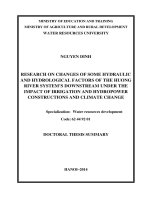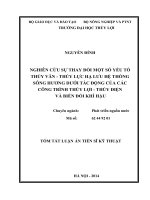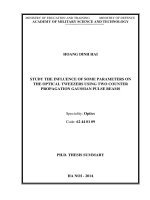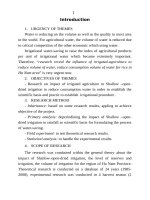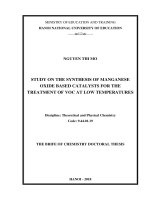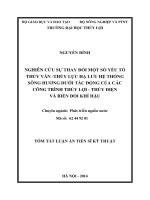tóm tắt luận án tiến sĩ tiếng anh nghiên cứu sự thay đổi một số yếu tố thủy văn - thủy lực hạ lưu hệ thống sông hương dưới tác động của các công trình thủy lợi - thủy điện và biến đổi
Bạn đang xem bản rút gọn của tài liệu. Xem và tải ngay bản đầy đủ của tài liệu tại đây (654.89 KB, 27 trang )
MINISTRY OF EDUCATION AND TRAINING
MINISTRY OF AGRICULTURE AND RURAL DEVELOPMENT
WATER RESOURCES UNIVERSITY
NGUYEN DINH
RESEARCH ON CHANGES OF SOME HYDRAULIC
AND HYDROLOGICAL FACTORS OF THE HUONG
RIVER SYSTEM’S DOWNSTREAM UNDER THE
IMPACT OF IRRIGATION AND HYDROPOWER
CONSTRUCTIONS AND CLIMATE CHANGE
Specialization: Water resources development
Code: 62 44 92 01
DOCTORAL THESIS SUMMARY
HANOI–2014
Research has been completed at Water Resources University
Science advisors:
Associate Prof. Le DinhThanh
Associate Prof. Hoang Minh Tuyen
Reviewer No.1:
Reviewer No.2:
Reviewer No.3:
Thesis will be defended from university thesis evaluating council of
Water Resources University
At(hour)(day)(month) 2014
Thesis can be found at:
- National Library
- Water Resources University Library
1
INTRODUCTION
The problem statement of thesis: Many irrigation and
hydropower constructions have been built on the Huong river basin,
which have significant impacts on the hydraulic and hydrological
regimes at downstream. Meanwhile climate change also impacts on
water resources in the basin. Therefore the research of thesis
“Research on changes of some hydraulic and hydrological factors of
the Huong river system’s downstream under the impact of irrigation
and hydropower construction and climate change” is necessary,
meeting the demand of socio-economic sustainable development in
the basin, particularly helpful for the activities of restructuring the
agricultural structure and developing Thua Thien Hue Province to be a
municipality.
Purpose of research: Clarifying the change of some
hydrology-hydraulic factors at downstream of Huong river system
under the impacts of irrigation and hydropower constructions and
climate change in order to propose adaptive measures to mitigate the
negative impacts on economic-social development and environmental
protection.
Objects and range of research: Assessing the impacts of
irrigation-hydropower construction system on some hydrology-
hydraulic factors at downstream of Huong river from reservoirs to
Thao Long dam with climate change calculated to the year of 2030.
Research methodology: Thesis has used these methods:
inheriting, investigating, surveying, statistic analysing, hydrology-
hydraulic mathematical modelling, GIS, system analysing, expert
method and community consulting
Summarizing new contributions of the thesis:
1) Assess quantitatively the impact of irrigation -
2
hydroelectric power constructions on the Huong river basin and the
impacts of climate change on hydraulic and hydrological factors in
downstream of the Huong river system.
2) Propose structural and non-structural measures to mitigate
the negative impacts of hydropower and irrigation works on the
Huong river basin to flow regime in downstream and improve the
efficient operation of those constructions.
Chapter I
LITERATURE RIVEW
1.1 OVERVIEW OF PREVIOUS RELATED STUDIES
The thesis overviewed 38 related studies in the world,
Vietnam and the Huong river basin.
1.1.1 Research in the world
There are many studies relating to the impact of reservoirs and
climate change on hydrology-hydraulic regime at downstream of
catchments around the world. These focus mainly on catchments
which have large scales and can be divided into two directions: (i)
comparing and analysing environmental changes between the periods
before and after constructions of reservoirs by observed data, and (ii)
Applying hydrological and hydraulic mathematical models to assess
the impacts on flow at downstream.
1.1.2 Research in Vietnam
In Vietnam, the assessment of impacts of constructions and
climate change to flow regime has been concerned recently,
particularly after great irrigations and hydropower constructions were
built on river systems. Studies about impacts of climate change focus
on assessing the change of water resources on watershed without
going further into detailed and quantitative assessment about impacts
3
of irrigation and hydropower constructions and climate change on
hydrology-hydraulic factors at downstream of river systems.
1.1.3 Constraints of previous research on Huong river basin
and corrective direction
Previous studies on Huong river basin assessing the impact
individually, while the integrated impact of constructions and climate
change on hydrology-hydraulic regime at downstream is not yet
comprehensive considered. Approaches of these research are not of
systematic and integrated, mostly based on the assumption that the
hydrological condition and ground surface remain unchanged.
Quantitative assessments are still restricted.
Corrective directions of thesis:
- Assessing system analysis perspective of Huong river basin,
concentrating on main structures which have considerable impact on
flow regime at downstream.
- Quantitatively assessing of impacts of constructions and climate
change, initially considering the role of land use and forest layer on
the basis of selecting annual flow and specific flood to study the
change of some typical hydrology-hydraulic factors.
- Proposing measures which are scientific-based, practical,
possible and effective.
1.1.4 Approach of thesis
- Integrated approach following the water system
- Imitative approach by hydrological and hydraulic mathematical
models
- Approach by scenarios
4
Figure 1.1: Research approaching diagram of thesis
Impacts of
upstream reservoirs
system
Propose
oriented
measures
Operating irrigation-
hydropower
reservoirs
Hydrology
-
hydraulic model
Change of
some factors
Changing flow
to reservoirs
Assess changing
tendency of
climatic factors
Rainfall
-
Runoff
model
Selecting
climate change
scenarios
Detailed climate
change scenarios
Impact of estuary
construction
Analyzing
impact factors
Gathering data of
climate, hydrology
and topographic
Comparing with
investigated
result
5
Figure 1.2
:
The
Huong river basin in Vietnam
6
1.2 CHARACTERISTICS OF THE HUONG RIVER BASIN
1.2.1 Physical characteristics
The Huong River Basin (HRB) locates mostly in Thua Thien Hue
Province (figure 1.2), including three main tributaries: Bo river, Huu Trach
river and Ta Trach river, the last of which is the main source of Huong river.
Water resources of HRB have a vital role in socio-economic-cultural
development and environmental protection of Thua Thien Hue province.
1.2.2 Socio-economic characteristics
In recent years on Huong river irrigation and hydropower
structures have been constructed in order to meet the demand of socio-
economic development. Constructions along with the change of
landuse structure have considerable impacts on hydrology-hydraulic
regime of Huong river.
1.3 CHANGING TENDENCY OF SOME HYDRO-
METEOROLOGY FACTORS ON HUONG RIVER BASIN
1.3.1 Data and trend assessment method
Research uses data of precipitaion, evaporation and water
level gathered from stations in the area to analyse and assess the
tendency of some hydrometorology factors by Mann Kendall
validating method and Sen method.
1.3.2 Changing tendency of some climatic factors
Precipitation characteristics tend to rise but not clearly (not meet
the 5% significant level). In contrast, evaporation seems to decrease. The
average temperature at mountain areas rises, when the figure at Hue is
about to drop slightly (not meet the 5% significant level).
1.3.3 Changing tendency of some hydrological factors
Water level characteristics at Kim Long and Phu Oc stations have the
trend to rise, appropriate with the increasing trend of rainfall on the catchment.
1.3.4 General assessment about changing tendency of some
hydrometeorology factors and scenarios of climate change and sea
water rise for Huong river basin
Result of tendency assessment shows that some hydro-
meteorology factors of Huong river basin have the changing trend that
suitable to climatic conditions, in which the typical factors are the
7
increasing trend of precipitation in both rainy and dry seasons, as well
as the maximum precipitation of 1, 3, 5, 7 days continuously, which
are the main factors causing flood in the basin.
In 2012, Ministry of Nature Resources and Environment
(MONRE) published scenarios of climate change and sea water rise for
Vietnam, in which data for Thua Thien Hue province ware also provided,
with the average amount of change in precipitation in 2030 period increases
by 2.1 percent compared with the base period of 1980-1999.
1.4 CONCLUSIONS OF CHAPTER I
Studies relating to Huong river basin so far have assessing the
impact of construction individually. Some research shows the
assessment about the impacts to flow regime but are still quantitatively
limited in changes of hydrology-hydraulic factors under the operations
of reservoirs at upstream and Thao Long dam at downstream,
particularly when climate change is setting out new challenges to
integrated water resources management in Huong river basin.
Changing tendency of some climatic and hydrological factors
in Huong river basin is quite suitable with the scenarios of climate
change and sea water rise published by MONRE in 2012. On the base
of research orientation and approach of thesis, applying hydrology-
hydraulic mathematical models and integrated analyzing are chosen to
be the major methods in assessing the impacts of main irrigation-
hydropower constructions in the river basin with published scenarios
of climate change and sea water rise No.B2.
Chapter II
ANALYSIS AND CALCULATIONS
2.1 IRRIGATION AND HYDROPOWER CONSTRUCTION
SYSTEM IN HUONG RIVER BASIN
2.1.1 Irrigation – hydropower constructions
Directly related to the main streams in the basin, there are
irrigation and hydropower constructions, weirs and dams for irrigation
combined with preventing saltwater intrusion and controlling flood and
flood drainage constructions at estuaries of Huong river and its branches.
8
2.1.2 Characteristics of irrigation – hydropower constructions
The constructions system is diverse, including upstream
reservoirs which have the function to control flood, supply water and
generate electricity and constructions at estuary for salt water
prevention and flood drainage.
2.1.3 Selection of researched constructions in the thesis
Criteria for selection: Volume of reservoir ≥ 100.10
6
m
3
,
Installed capacity ≥ 30MW for hydropower reservoirs, ≥ 10MW for
combined function reservoirs, Thao Long dam at estuary of Huong
River has a great impact on dry season flow of the whole system,
therefore the reservoirs of Binh Dien, Huong Dien, Ta Trach and Thao
Long dam are put in research.
2.1.4 Impact assessment framework
Based on the analysis and selection of researched
constructions, the impact assessment framework and researching
situations are indicated in figure 2.2
2.2 MAIN FACTORS AFFECTING THE HYDROLOGY -
HYDRAULIC REGIME OF HUONG RIVER
2.2.1 Rain, storms and weather phenomena causing flood
Impact of constructions
Impact of constructions and climate change
No construction
calculated,
Binh Dien, Huong Dien, Ta Trach
reservoirs and Thao Long dam
calculated without climat
e changed
Binh Dien, Huong Dien, Ta Trach
reservoirs and Thao Long dam
calculated, climate change
considered
Propose measures to mitigate
Figure
2
.2
:
Impact assessment framework of irrigation
-
hydropower constructions
and climate change to some hydrology-hydraulic factors of Huong River
9
The regime of precipitation distributes irregularly in both in
space and time, creates a great differentiation in hydrology-hydraulic
regime of Huong River, with the flow depleted in dry season and
overflow causing flooding in rain season everyyear.
Storm is an important figure that have a great impact on
hydrology-hydraulic regime of Huong River, particularly the flood
flow. Storms and tropical depressions combined with other weather
phenomena often create downpour and thunderstorms, causing severe
flooding at downstream delta and lagoon areas.
2.2.2 Conditions of topography and land cover
Mountain and coastal direction is nearly perpendicular with main
wind direction, which has the effect to block the wind, causing heavy rain.
The watershed has the shape of a large sink, the mountain area is very close
to the delta-lagoon area, which causes a fierce property of flood flow.
Forest cover rate is quite high while the role to control flow of
the vegetative cover is low due to the low rate of primary forest, which
are decreasing.
2.2.3 Lagoons and tide
Before Thao Long dam’s construction, Tam Giang – Cau Hai
lagoon system has a significant impact on flow regime of Huong
River. With the property that low tide goes along with dry season and
high tede come at the same time with flood season, the impact of tide
makes it even more dificult to supply water in dry season due to
saltwater intrusion, and flood draining in flood season.
2.2.4 Socio-economic activities in the watershed
In the period of 2007-2009, Thao Long dam raised the mean
annual water level of Kim Long and Phu Oc by 26-27cm, the lowest
and highest water level in dry season increased by 20-31cm, the figure
for flood season is 4cm at Kim Long and 22cm at Phu Oc. In the
period of 2010-2012, Binh Dien reservoir and Huong Dien reservoir
lowered the highest annual water lever at Kim Long by 53cm and Phu
Oc by 37cm, as well as raised the lowest mean water level in dry
season at Kim Long by 37cm and at Phu Oc by 22cm.
10
2.3 MAIN IMPACTS OF IRRIGATION-HYDROPOWER
CONSTRUCTIONS ON HYDROLOGY - HYDRAULIC
REGIME AT DOWNSTREAM OF HUONG RIVER
2.3.1 In flood season
In flood season, reservoirs have the impact to lower the water
level and peak flow at downstream due to flood controlling. However,
they are also able to cause artificial flood unless reservoir operating
procedure is implemented. Sediment is hold in reservoirs, cause to river
bed transformation at downstream, increasing incident risk…
2.3.2 In dry season
Thao Long dam controls the flow of the river and freshens
Huong river, creating the potential to supply water for Truoi irrigation
system and maintaining flow for environmental requirement. This
dam has a vital role in preventing saltwater from entering the river,
even though by sea water rise.
2.4 APPLYING HEC-HMS AND HEC-RAS MODEL IN
SIMULATING FLOW IN HUONG RIVER BASIN
2.4.1 General introduction of HEC-HMS and HEC-RAS model
HEC-HMS hydrological model is applied for flow simulation to
reservoir and inflow from tributaries, which result is used for input data of
HEC-RAS hydraulic model to calculate flow to downstream according to
operating plans of reservoir which are programmed by controlling code.
The two models are closely connected to DSS data base.
2.4.2 Applying HEC-HMS and HEC-RAS models for HRB
This thesis has used data of 278 cross sections measures and
undated to the year of 2009, including: 18 sections of Huu Trach river, 24
in Ta Trach river, 59 in Huong river, 37 in Bo river and 140 in flood
draining routes at downstream. 27 storage cells were built, with Z-W
relation calculated by HEC-GeoRAS software. Precipitation, discharge
and observed water level data are used in calculations.
By steps of forming CN coefficients map, creating hydrology-
hydraulic system, calibrating and validating models, results showed
that HEC-HMS’s parameters meet the requirement, with Nash
coefficient is 0.90-0.92 (calibration, figures 2.17) and 0.78-0.95
11
(validation, figures 2.21); the coeficient for HEC-RAS is 0.63-0.77
(figure 2.26, 2.27)
Figure 2.17: Calibration of Figure 2.21: Validation of
HEC-HMS at Binh Dien HEC-HMS at Duong Hoa
Figure 2.26: Calibration of Figure 2.27: Validation of
HEC-RAS at Kim Long HEC-RAS at Phu Oc
2.5 CONCLUSIONS OF CHAPTER II
Upstream reservoirs, including Ta Trach, Binh Dien and
Huong Dien and Thao Long dam at downstream hold an important
role in impacting the hydrology-hydraulic regime at downstream
Huong river. These construction are included in research of thesis.
Operations of Thao Long, Binh Dien and Huong Dien
constructions are not so long. However results from analysis have
shown that there are significant impacts on some hydrology-hydraulic
factors in Huong river. Therefore quantitative assessment in specific
situation is necessary, especially when Ta Trach reservoir went in
active and climate change considered.
12
HEC-HMS and HEC-RAS models are applied in Huong River
for daily flow, flow in flood season and dry season. Results for
calibration and validation of models are acceptable for assessing
change of hydrology-hydraulic factors under the impact of
constructions and climate change.
Chapter III
RESULTS AND DISCUSSION
3.1 RESEARCH SITUATIONS AND OPERATING PLANS
FOR CONSTRUCTION SYSTEM
3.1.1 Research situations
This thesis considers 3 scenarios: (1) Natural condition, with
no construction calculated; (2) Binh Dien, Huong Dien, Ta Trach
reservoirs and Thao Long dam are constructed, with none climate
change applied and (3) Those constructions are calculated, with
climate change to 2030 considered according to scenarios No.B2
published by Ministry of Natural Resources and Environment in 2012.
3.1.2 Operating plans of constructions for impact assessment
Table 3.1: Calculating plans
No
Plan name
Calculating condition
1
TH1
Natural flow
,
no construction
calculated
2
TH2
-
PAI
Binh Dien, Huong Dien Ta T
rach reservoirs and
Thao Long dam constructed and operated by
individual procudures
3
TH2
-
PAII
Binh Dien, Huong Dien Ta Trach reservoirs and
Thao Long dam constructed and operated
according to downstream alerted level
4
TH2
-
PAIII
Constructions calculated
and operated according
to downstream alerted level, with flood control
pool added to reservoirs
5
TH3
-
PAI
Constructions calculated and operated by
indi
vidual procedures, with climate change
considered to 2030 in B2 scenarios
6
TH3
-
PAII
Constructions ca
lculated and operated according
to downstream alerted level, with climate change
considered to 2030 in B2 scenarios
13
3.1.3 Specifying typical year and rainfall according to scenarios to
year of 2030
By the work of considering hydrometerology data, this thesis
chose the year 1984, which is an average water year, to assess annual
flow and dry weather flow. To assess impacts on flood flow, the thesis
chose the historical flood in the year 1999, which rainfall had in delta
area greater than in mountain area, and in 1983, which had rainfall in
mountain area greater than in delta area.
The calculated rainfall in climate change condition is
identified by the amount of change in precipitation according to B2
scenarios (MONRE, 2012).
3.2 THE IMPACTS OF CONSTRUCTION SYSTEM AND
CLIMATE CHANGE ON SOME HYDROLOGY-HYDRAULIC
FACTORS AT DOWNSTREAM OF HUONG RIVER
3.2.1 Locations for validating and assessing flow changes at
Huong River downstream
The locations for validating and assessing change of hydrology-
hydraulic factors at downstream of Huong river are Kim Long station
and Phu Oc station. These are the two most important level controlling
point for flood alert for Hue city and the downstream delta.
3.2.2 Impact on daily flow
Results of simulating mean daily water lever in average water
year at Kim Long for each scenario with operating plan No.1 are
shown in figure 3.2 and table 3.4.
Figure 3.2: Water level change at Kim Long in average water year
14
Table 3.4: Chane in mean water level in average water year
Point
TH1
TH2
-
PA
I
TH3
-
PA
I
H
0
(m)
H
1
(m)
H
1
-
H
0
H
2
(m)
H
2
-
H
0
Kim Long 0.04 0.68 +0.64 0.69 +0.01
Phú Ốc 0.42 1.02 +0.60 1.06 +0.04
When climate change is not considered, the mean annual
water level at downstream of Huong river in an average water year
under the impact of constructions has a rising trend, about 0.60 m
compared with none-construction situation. With climate change
calculated, water level of Huong river rises insignificantly with the
impact of constructions. This shows that the change of flow at
downstream is greater affected by irrigation-hydropower system than by
climate change according to research scenarios.
Before the existence of constructions, water stage in dry season
fluctuated by the tide, in flood season the level changed abruptly with
high peak of flow. After having constructions, water level in dry season
maintained stably without fluctuating with the tide; in flood season, the
peak flow has been lowered, the period of over second-grade warning
stage at Kim Long has reduced from 4 days to 2 days while the period
of over first-grade warning stage has increased from 9 days to 47 – 53
days.
3.2.3 Impacts on flood flow
Results of calculating flood flow at Huong river downstream
for each plan are shown in figures 3.4, 3.6 and tables 3.6, 3.8.
Table 3.6: Calculated peak water level change in 1999 at downstream
of Huong river for each plan (m)
Point
TH1 TH2- PAI TH2-PAII TH2-PAIII
H
0
(m) H
1
(m) H
1
-H
0
H
2
(m) H
2
-H
0
H
3
(m) H
3
-H
0
Kim Long
6.09 5.81 -0.28
5.13 -0.96 5.10 -0.99
Phú
Ốc
4.68 4.60 -0.08
4.48 -0.20 4.47 -0.21
15
Figure 3.4: Graph of calculated Figure 3.6: Graph of calculated
flood stage in 1999 at Kim Long flood stage in 1983 at Kim Long
When climate change is not calculated, analysis of some flood
properties in 1999 at Kim Long station shows that the flood regime has
changed considerably under the impacts of reservoirs. After the
constructions of reservoirs, the peak flow has lowered, maximum flood
intensity has decreased from 0.54m/hour to 0.24 – 0.52 m/hour, average
flood intensity has also decreased from 0.2 m/hour to 0.1 – 0.15 m/hour
depending on operating plans. The period of over third-grade warning
stage has also been reduced by 4 – 8 hours.
Table 3.8: Change of simulated peak flood stage in 1983 at Huong
river downstream according to operating plans (m)
Point
TH1
TH2
-
PAI
TH2
-
PAII
TH2
-
PA
III
H
0
(m)
H
1
(m)
H
1
-
H
0
H
2
(m)
H
2
-
H
0
H
3
(m)
H
3
-
H
0
Kim Long
5
.
00
4
.
7
0
-
0
.
3
0
3
.
81
-
1
.
19
3
.
56
-
1
.
44
Ph
u Oc
4
.
73
4
.
4
3
-
0
.
3
0
4
.
4
1
-
0
.
3
2
4
.
3
0
-
0
.
43
For the 1983 flood, result shows that characteristics at Kim Long
witnessed a significant change. Without the apperance of reservoirs, the
maximun flood intensity reached 0.35 m/hour, and dropped to 0.14 – 0.33
m/hour after reservoirs are constructed. The average flood intensity
decreased from 0.09 m/hour to 0.05 – 0.07 m/hour depending on the
operating plan. The period of over third-grade warning stage was reduced
by 8 – 9 hours. Flood is more regulated.
With climate changed considered, results of calculation for the
historical flood in 1999 are shown in figures 3.8, 3.9 and table 3.10
16
Figure 3.8: Graph of calculated Figure 3.9: Graph of calculated
flood stage in 1999 at Kim Long, flood stage in 1999 at Kim Long,
plan I, climate change considered plan II, climate change considered
Table 3.10: Change of peak flood stage in 1999 at Huong River
downstream with climate change calculated (m)
Point
TH1
PA I
PA II
H
0
(m)
TH2
(H
1
)
TH3
(H
2
)
H
2
-
H
1
(m)
TH2
(H
3
)
TH3
(H
4
)
H
4
-
H
3
(m)
Kim Long
6
.
09
5
.
81
6
.
15
+ 0
.
34
5
.
13
5
.
32
+ 0
.
2
9
Phu Oc
4
.
68
4
.
60
4
.
71
+ 0
.
11
4
.
48
4
.
56
+ 0
.
08
Generally, research has shown that the change of flood flow
regime at downstream of Huong river flow depends greatly on flood
controlling operation mode of upsream reservoirs, particularly Ta
Trach reservoir. Both plans PAII (combined operating) and PA III
(combined operating + increasing flood control volume) decreased the
peak flood stage by 1.2 – 1.4m, guaranting 1983 flood controlling
criteria for Hue city.
Also in research, the impacts of climate change for each plan of
operation on change of peak flood stage at downstream in are
inconsiderable compared to the impacts of reservoirs.
3.2.4 Impacts on dry season flow
Results of calculation for dry flow stage (Jan-Aug) in an
average water year for individual operating plan are shown in table
3.11.
17
Table 3.11: Change of dry flow stage in average water year
Point
TH1
TH2
-
PAI
TH3
-
PAI
H
1
(m)
H
2
(m)
H
2
-
H
1
H
3
(m)
H
3
-
H
2
Kim Long
-
0
.
11
0
.
52
+0
.
63
0
.
52
0
.
00
Ph
u Oc
0
.
17
0
.
74
+0
.
57
0
.
75
+0
.
01
Result shows that in dry season, the role of Thao Long dam
and reservoirs is essential. They increase mean water level at
downstream to about 0.6m. In case of climate change considered,
calculation shows that mean water level in dry season to the year of
2030 at Kim Long and Phu Oc remain nearly unchanged.
At Kim Long, after existences of constructions, the lowest
mean stage in dry season is +0.44m, that can ensure water supply for
Huong river delta area and transporting water for Phu Loc area
(supporting Truoi reservoir).
3.2.5 Impacts on sediment issue at downstream
Research has shown that water level at Binh Dien station falls
significantly along with flow levels. With the same discharge, the
stage dropped by about 40cm compared to when reservoir is not yet
constructed. Due to the limited data of only ome year of investigating
after Binh Dien operation, this thesis could not fully and correctly
indicate the reason of this drop. However it can tell that Binh Dien
reservoir has certain impacts of change of sediment at downstream,
being one of the reasons for riverbed erosion and changes of
hyrology-hydraulic relations. When Ta Trach reservoir is in operation,
progress Q-H relation will have more changes.
3.3 PROPOSING ORIENTED MEASURES TO MITIGATE
NEGATIVE IMPACTS AND IMPROVING EFFICIENT
OPERATION OF IRRIGATION-HYDROPOWER
CONSTRUCTIONS
3.3.1 Purposes and basis of proposing solution
18
- Mitigate the negative impacts of irrigation-hydropower
constructions to downstream in flood and dry season for socio-
economic development and environmental protection.
- Improve the efficiency of constructions in order to disentangle the
conflict between electricity generation and flood control, mitigate
losses to downstream.
3.3.2 Nonstructural measures
(1) Enforcing the vegetative cover on the basin:
Based on CN coefficient of land use and vegetative cover
scenarios, the applying of HEC-HMS model has estimated flood flow to
reservoirs in 1983. It is estimated correlation function between CN
coefficient to flood volume that comes into the reservoirs: y= 13.19x
+2676, R
2
=0.994. Result of peak flow and stage of 1983 flood at Kim
Long and Phu Oc according to land cover scenarios is shown in table 3.16.
Table 3.16: Influence of change of land use and vegetative cover to
flood flow in 1983 at downstream of Huong River
Kim Long Phu Oc
Year H
max
(m)
ΔH
(m)
Q
max
(m
3
/s)
ΔQ
(m
3
/s)
H
max
(m)
ΔH
(m)
Q
max
(m
3
/s)
ΔQ
(m
3
/s)
1983 5.00 5907 4.73 1801
2020 5.00 0.00 5898 -9 4.73 0.00 1797 -4
2030 5.00 0.00 5891 -16 4.71 -0.02 1776 -25
2050 4.98 -0.02 5880 -27 4.69 -0.04 1759 -42
As can be seen, forest cover and landuse have impacted the
flood flow but this differs for each area, with the impact at upstream
being more significant than one at downstream. Forestation needs to
be enforced in these critical areas:
- Upstream areas of reservoirs(including small reservoir)
- Afforest at the belts along the downstream river and coastal strip.
- Planting and protecting the forest is integrated river basin
19
management, in which water resources management is the key factor.
(2) Planing, buliding and protecting the protecting corridor
of reservoirs, river, lagoon.
(3) Building inter-reservoir operating procedures co-
operated with Thao Long dam
This thesis proposes the Combined operating procedure of
irrigation-hydropower constructions in Huong river basin as below:
(1) For upstream reservoirs
a)- Binh Dien reservoir:
- Flood control elevation: +80.6m.
- With incoming flood, store inflow to the eleveation of +85.0
m then discharge with Q
discharge
≤ Q
inflow
and cooperate with
downstream flood control requirement. Amount of discharge depend
on warning stage at Kim Long.
- After flood, reservoir keeps on dischaging to drop the water
elevation to +80.6m in order to engage the following flood.
b) Huong Dien reservoir:
- Flood control elevationL +56.0m.
- When flood come, store inflow to the elevation of +58.0m
the discharge with the flow smaller than inflow and coperate with
warning stage at Phu Oc.
- After flood, continue on discharging opeartion to drop the
water elevetion to +58.0m
c) Ta Trach reservoir:
- Before flood season, keep the water elevation of reservoir at
+25.0m for flood controlling.
- When flood comes and water elevation rise from +25 m to
+46.97 m, discharge with the flow lower than inflow and coperate
with warning stage at Kim Long.
- After flood, continue discharging operation to drop the
water elevation to +45.0 m.
20
(2) For Thao Long dam at downstream
In flood season, Thao Long dam should be totally open in
order to maximize flood draining. In case of high tidal elevation, lift
the floodgate to prevent saltwater intrusion (by small flood, high
tide, )
The efficiency to flood control by cooperated plan compared
to individual operation is shown in table 3.17.
Table 3.17: The efficiency to flood control by coopearated plan
compared to individual operation (m)
1983 Flood 1999 Flood
Point PA I PA II Reduced
PA I PA II Reduced
Kim Long 4.70 3.81 -0.89 5.81 5.13 -0.68
Phú Ốc 4.43 4.41 -0.02 4.60 4.48 -0.12
3.3.3 Structural measures
(1) Increase flood control storage of Binh Dien and Huong Dien reservoirs
Table 3.18: Proposed flood control storage of reservoirs
Now Proposed
Reservoir V
FC
(10
6
m
3
) % V
E
V
FC
(10
6
m
3
) % V
E
Ta Trach 435.9 125.8 435.9 125.8
Binh Dien 70 20.3 150 43.6
Huong Dien 0 0 200 57.0
Total 505.9 48.6 785.9 75.4
Table 3.19: The efficiency to flood control at downstream by integrated
operation and flood control storage increase of reservoirs in comparision with
keeping flood control storage constant and individually operation (m)
1983 Flood 1999 Flood
Point
TH2-
PAI
TH2-
PAIII
Reduction
level
TH2-
PAI
TH2-
PAIII
Reduction
level
Kim Long
4.70 3.56 -1.14 5.81 5.10 -0.71
Phu Oc 4.43 4.30 -0.13 4.60 4.47 -0.13
21
As can be seen, increasing total flood storage and integrated
operation of upstream reservoirs would have led to greatly effective
flood reduction in both 1983 and 1999 floods. Particularly the peak
water level at Kim Long been lowered by 1.14m for 1983 flood and
0.71 for 1999 in comparison with keeping flood control storage
constant and individually operation. Both PAII and PAIII plans
reduced peak water stage in 1983 by 1.19 – 1.44m. Consequently,
peak elevation at Kim Long reachs +3.69m (PAII) and +3.44 m
(PAIII), that meet the requirement of flood control in 1983 for Hue
city.
Research has shown that the measure to increase total flood
control storage for upstream reservoirs is acceptable. However, it is
necessary to have deeper and more detailed research to smoothly
disentangle the conflict of flood control and electricity generation of
private hydropower constructions for stronger and more pratical
foundations for later implementation.
(2) Improving and upgrading flood drainage and sea dike
Improve and extend downstream rivers and creeks such as
Dien Hong, An Xuan, Kim Doi in the northen area of Huong river;
silted section of Nhu Y, Pho Loi, Dai Giang river; improve and
upgrade drainage, pump station and overflow dike lines on Tam Giang
– Cau Hai lagoon. Dike routes that need to be upgraded include east
and west routes of Tam Giang lagoon and routes of Sam – Thuy Tu –
Cau Hai lagoon in order to prevent sea water rising.
3.4 CONCLUSIONS OF CHAPTER III
Impacts of irrigation-hydropower constructions in Huong
river basin on downstream flow regime is considerable. It is necessary
to concern with (i)-Binh Dien and Huong Dien reservoir operating
procedures in flood season; and (ii)- main role in flood reduction of
flood control storage, typically Ta Trach reservoir and tide prevention
role of Thao Long dam.
Impact of climate change (B2) to the year of 2030 on annual
flow and dry season flow at downstream is insignificant compared to
impacts of constructions. For flood flow, in case of extreme flood
22
(1999), impacts of climate change become more apparent.
The oriented measures to mitigate the negative impacts include the
group of nonstructural solutions: Enforcing afforestation in watershed,
constructing water preservation corridor and building inter-reservoir
operating procedures in cooperation with Thao Long dam. The group of
structural solutions includes increasing total flood control storage of
reservoirs, improving and upgrading flood drainages and sea dikes.
CONCLUSION AND RECOMMENDATION
Conclusions
Main results of thesis in assessing the impact of irrigation-
hydropower constructions system and climate change on some
hydrology-hydraulic factors at downstream of Huong river based on
integrated and systematic approach perspective and advanced
calculations, particularly hydrology-hydraulic mathematical models,
has shown that:
1) Changing tendency of some hydrometerology factors in
Huong river basin to the year 2030 has been researched and identified
that it is available with scenarios of climate change of Ministry of
Natural Resources and Environment.
2) Impacts of irrigation-hydropower constructions on some
hydrology-hydraulic factors at downstream are transparent and
considerable, which are presented in specific quantitative results:
-Regardless of mean annual water level of typical year (1984):
Thao Long dam and Binh Dien, Huong Dien, Ta Trach reservoirs
system have leveled up mean annual water level at downstream
significantly, with the figure at Kim Long raised by 0.64 m, at Phu Oc
by 0.6 m.
-Regardless of peak flood stage: All three operating plans of
constructions system (individual operating, integrated operating with
warning stage at downstream considered, integrated operating and
increasing flood control storage) drop sharply the peak flood stage at
downstream of Huong river. In term of the 1983 flood, peak stage
23
dropped by 0.30 – 1.44 m at Kim Long, 0.3 – 0.43 m at Phu Oc; in
term of the 1999 flood, the figures are 0.28 – 0.99 m at Kim Long and
0.08 – 0.21 m at Phu Oc.
-Regardless of mean dry season water stage (Jan-Aug): The
role of constructions with mean water level is significant, particularly
for Thao Long dam. Water level at downstream in dry season is stable
without influence of tide and rise significantly (about 0.60 m) at both
Kim Long and Phu Oc.
3) Impacts of climate change on Huong river basin according
to B2 scenarios on some hydrology-hydraulic factors of downstream
is generally inconsiderable compared to impacts of irrigation-
hydropower constructions system in the period to 2030. In case of
extreme flood (1999), impacts of climate change become more
transparent.
4) Based on results of reseach, analysis, scientific assessment
and pratice, this thesis proposes two groups of solutions in order to
mitigate disadvantageous impacts and improve efficiency of
constructions:
-Nonstructural solutions include: (i)”Enforcing vegetative
cover in watershed”; (ii)”Planning, building and protecting
preservation corridor of water in rivers, reservoirs, lagoons”; and
(iii)”Building inter-reservoir operating procedures in cooperation with
Thao Long dam”.
-Structural solutions include: (i)”Increasing flood control
storage of Binh Dien and Huong Dien reservoirs”; and (ii)”Improving
and upgrading flood draining routes and sea dikes”.
These measures are possible and suitable with requirements
and sustainable developing direction of Thua Thien Hue Province.
New contributions of the thesis
The thesis has been 2 new contributions (see introduction)
Recommendations
1) In fact, irrigation-hydrology constructions system that put
in research include three main reservoirs (Binh Dien, Huong Dien, Ta
Trach) and Thao Long dam, in which two hydropower reservoirs Binh

